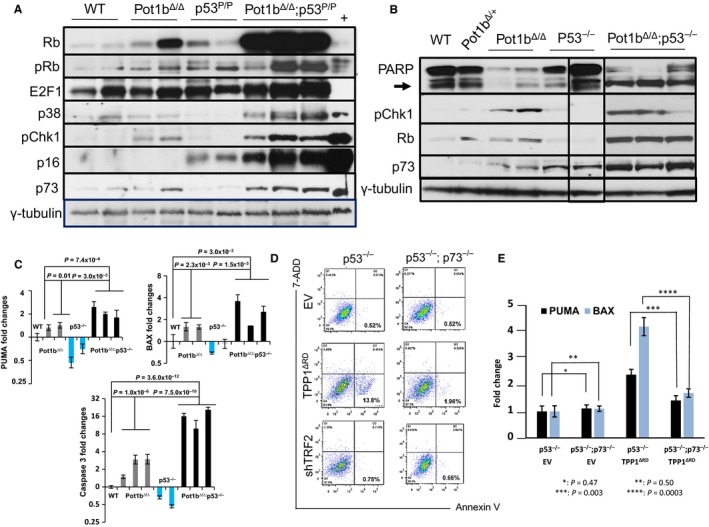Figure 6.

Activation of p53 independent apoptosis in Pot1b Δ/ ; p53 −/− mice. (A) Immunoblotting for total Rb, phosphorylated‐Rb, E2F1, p38 MAP kinase, phosphorylated‐Chk1, p16 and p73 expression in mouse spleen cells of the indicated genotypes. γ‐tubulin was used as the loading control. (B) Western analysis for PARP, cleaved PARP (arrow), phospho‐Chk1, total Rb and p73 expression in mouse spleen cells of the indicated genotypes. γ‐tubulin was used as the loading control. Samples were run on the same gel but the lanes were not all contiguous. (C) Real‐time RT‐PCR results showing the expression of PUMA (upper left), BAX (upper right) and Caspase 3 (lower) in spleen cells from WT, Pot1b Δ/Δ , p53 −/− and Pot1bΔ/Δ ; p53 −/− mice. Each experiment was repeated in triplicate. Error bars represent SEM. (D) Representative FACS analysis of Annexin V and 7‐AAD expression in p53 −/− and p53 −/− ; p73 −/− MEFs 72 h after treatment with empty vector (EV), TPP1ΔRD or shTRF2. p53 −/− MEFs treated with TPP1ΔRD displayed increased number of Annexin‐V+, 7‐AAD‐ cells, which was significantly reduced in p53 −/− ;p73 −/− MEFs. (E) Real‐time (RT)‐PCR analysis of PUMA and BAX expression profiles in p53 −/− and p53 −/− ; p73 −/− MEFs after 72 h of treatment with EV or TPP1ΔRD. Compared with p53−/− MEFs expressing TPP1ΔRD, PUMA and BAX expression was largely abrogated in p53 −/− ; p73 −/− MEFs expressing TPP1ΔRD. Each experiment was repeated in triplicate. Error bars represent SEM. A 2‐way ANOVA analysis was performed to calculate statistical significance.
